| Oracle® Argus Insight Cognos Installation Guide, Release 6.0 E18251-01 |
|
 Previous |
 Next |
This chapter describes the steps required to run and work with the Initial ETL.
Before running the Initial ETL, ensure that Auto extend is set to ON for all the Data files in the database that are related to Staging and Mart. You should also be aware of the following:
Because the initial ETL requires a huge amount of Temp space, set the Temp space to 100 GB to prevent data errors. After completing the Initial ETL reduce the temp space to 30 GB.
After the Initial ETL completes, the balancing log may show differences between the Argus/Stage and MART table counts. This is because of the derivation rules applied to the datamart.
The system may display the following message:
Warning !!! - Could not locate MedDRA-J User in the Argus Database.
Ignore this warning for all MedDRA tables.
Do not run incremental ETL for more than 50,000 cases. Run the Initial ETL again if the number of cases exceeds 50,000.
Use the following procedure to run the initial ETL.
Log on to the Argus Insight Web Server as an Admin user.
Select Start > Programs > Oracle > Argus Insight > Schema Creation Tool.
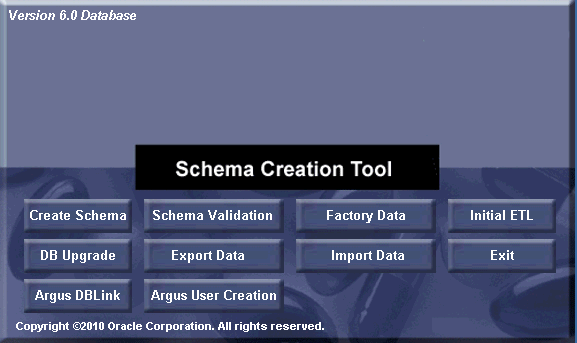
When the system opens the Schema Creation Tool, click Initial ETL.
When the system opens the Oracle Database Connect dialog box, enter the APR_MART password and database name in their respective fields. Click OK.

When the system opens the Initial ETL Status dialog box, click Start ETL to start the Initial ETL process.
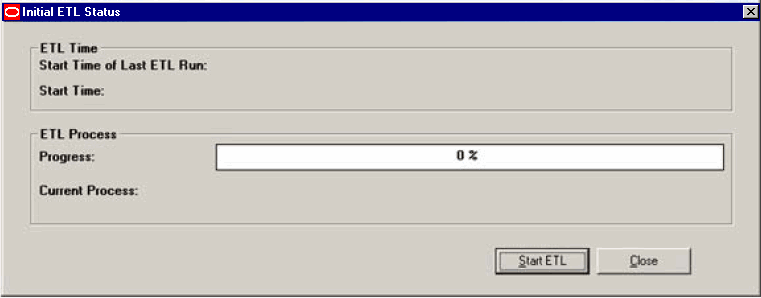
When the system opens the Initial ETL Configuration Check dialog box, click Yes if these items have already been configured.

The system presents a processing dialog box showing the ETL start time, current process in execution, and the progress bar while ETL is in progress.
Stop ETL and Close buttons are also available.
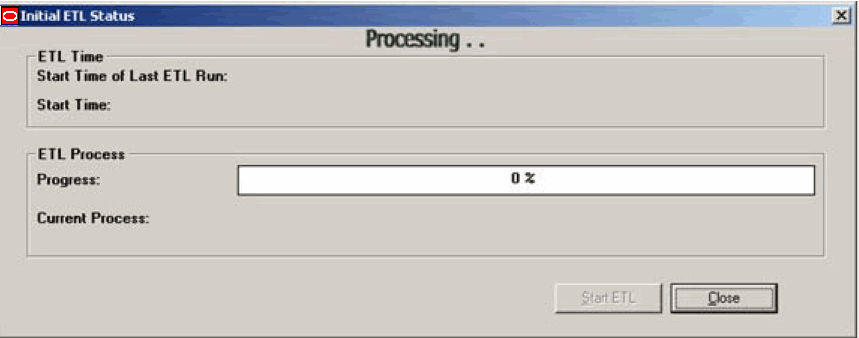
|
Note: Closing the Schema Creation Tool application does not impact the execution of ETL process.Ignore option is not available for stopped process. Click Stop ETL to halt the ETL process. Click Continue to continue the stopped ETL process. |
You can halt execution of Initial ETL process by clicking Stop ETL.
Click Continue to continue the stopped ETL process.

When the system shows the Initial ETL process completes successfully with 100% displayed in the progress bar, click Balancing Logs.
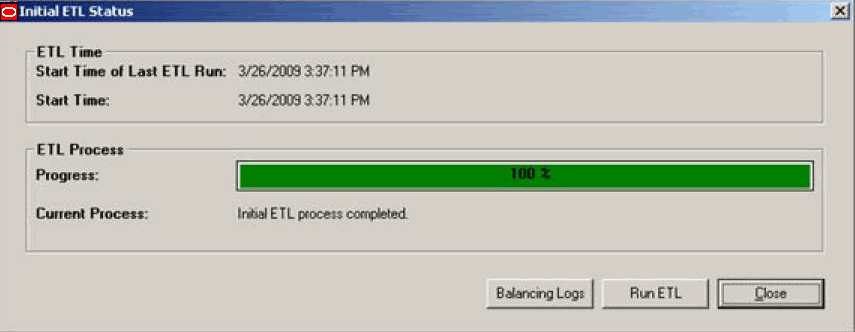
When the system opens the Balancing Logs dialog box, click OK.
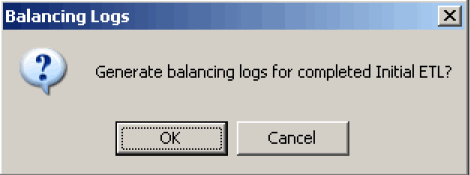
The system presents a command screen.

When the system opens the following dialog box showing the location of the balancing log reports generated with the report names, click OK.
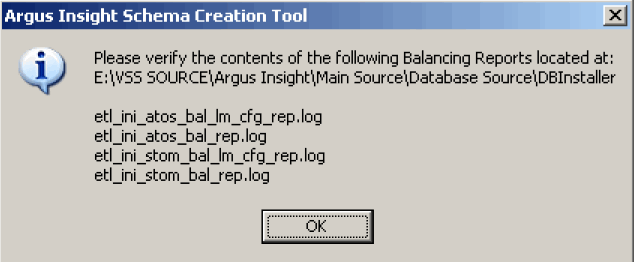
Click Run ETL (from the Initial ETL Status dialog, as shown in Step 8) if you want to start the Initial ETL process from the beginning after confirmation message and APR_MART password input.
Click Continue to continue the failed Initial ETL procedure.
Ignore option is also available to ignore the failed Initial ETL process.
Click Restart ETL to start the Initial ETL process from beginning after confirmation message and APR_MART password input.
Use the following procedure to close the Initial ETL Status dialog.
Click Close.

When the system opens the Close Application dialog box, click OK.

Use the following procedure to halt the execution of the Initial ETL process:
Click Stop ETL.

When the system opens the Stop ETL confirmation dialog box, click OK.
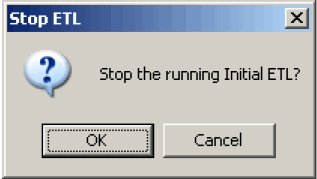
The system redisplays the Initial ETL Status dialog box.
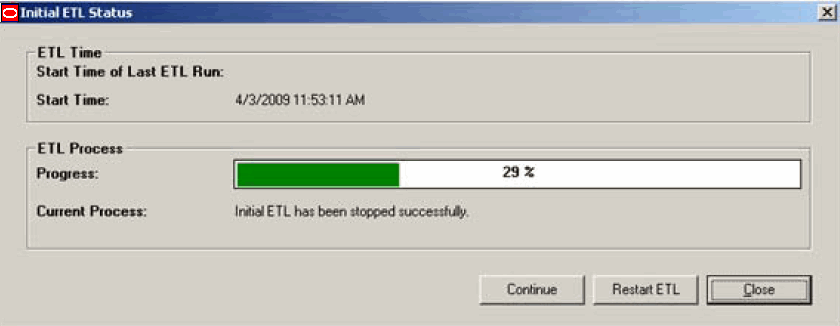
Use the following procedure to start the ETL process from the beginning.
Click Run ETL.

When the system opens the Run ETL dialog box, click OK.
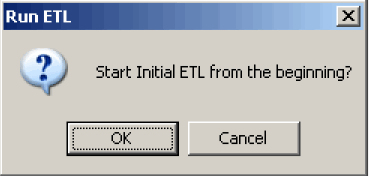
The following dialog is displayed. Enter the APR_MART password and click OK.

The initial ETL process starts from the beginning.
You can choose any of the following options for the failed Initial ETL process.
Click Continue to continue the failed Initial ETL procedure.
Click Ignore to ignore the failed Initial ETL process.
Click Modify Attributes of ETL Data Exclusion if PRE_REQ_CHECK_FLAG switch is set to ABORT.
|
Note: These modifications must be done before running the Initial ETL process. |
Use the following procedure to continue a failed ETL procedure. Execute the following steps to continue the Initial ETL process from the failed ETL procedure.

Double-click on the ETL error to view the Error Data dialog containing the details of that error. Click OK.
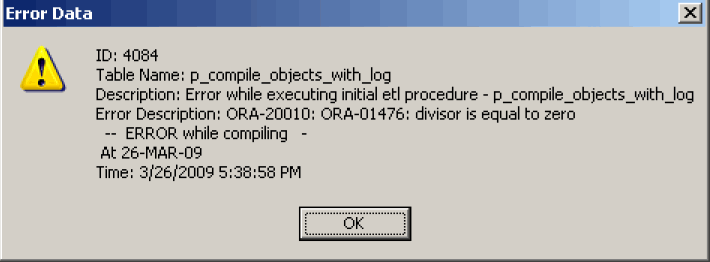
Right-click on the ETL Error and click Copy to copy the error data.

Click Continue to continue the failed ETL process.
When the system opens the Continue ETL dialog box, click OK.
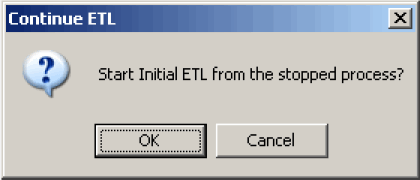
The system continues with the ETL process (if no errors are found).
The system continues executing the initial ETL.

Use the following procedure to start the Initial ETL process by ignoring the failed Initial ETL procedure:
When the system opens the Initial ETL Status dialog box, click Ignore.

When the system opens the Ignore Error dialog box, click OK.

The system starts the Initial ETL from the next process.

Use the following procedure to modify ETL Data Exclusion attributes. You must modify these attributes before ETL execution.
Log on to the Argus Insight Web Server as an Admin user.
Select Tools > List Maintenance > Profile Switches > ETL Data Exclusion.
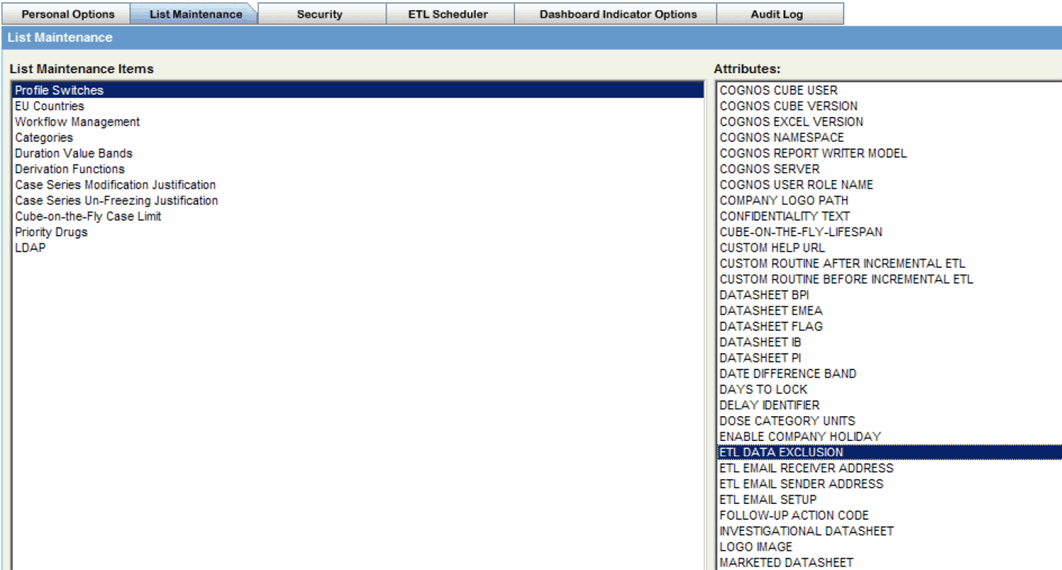
Click Modify.
When the system opens the following dialog box do one of the following and click OK:

Enter IGNORE in the Value field if you want to continue the ETL process and skip cases with erroneous data.
Enter ABORT in the Value field if you want the ETL process to abort when it encounters cases with erroneous data.
Use the following procedure to restart the the Initial ETL process starting from after the confirmation message and APR_MART password input:
When the system opens the following dialog box, click Restart ETL.

When the system opens the Restart ETL dialog box, click OK.

When the system opens the Oracle Database Connect dialog box:

Enter the APR_MART password in the Password field.
Enter the database name in the Database field.
Click OK.
When the system opens The Initial ETL Configuration Check dialog box, click Yes if the listed items have already been configured.

The system proceeds with the ETL process. When the system finishes the ETL process, click Close.
